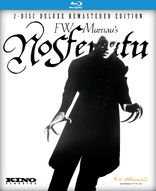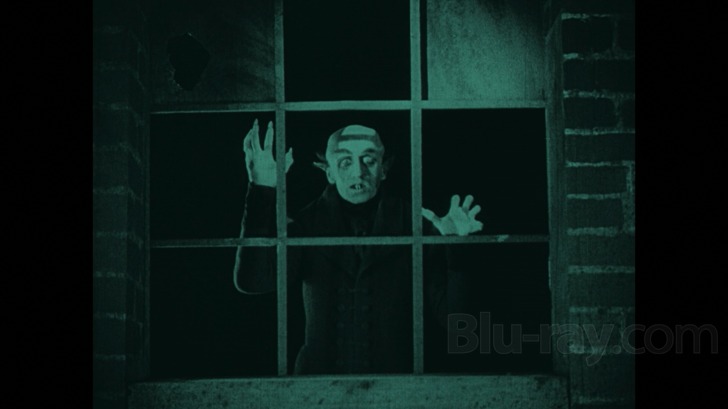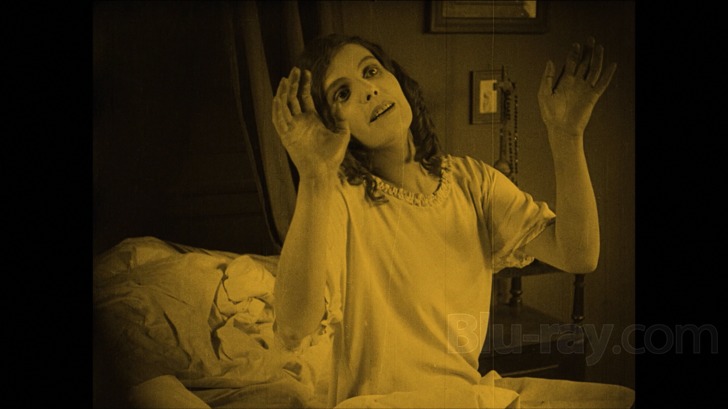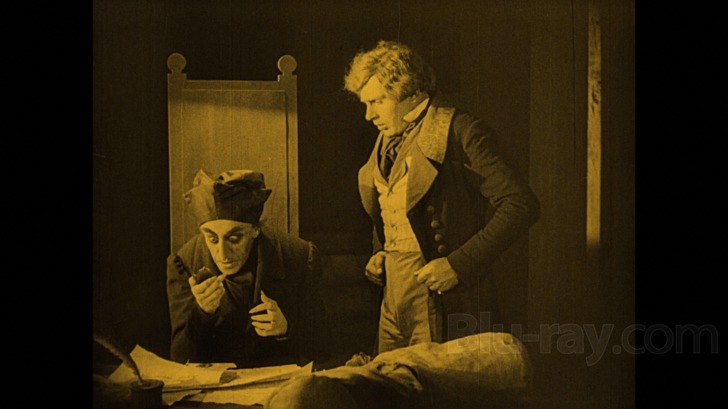Nosferatu Blu-ray Movie
HomeNosferatu Blu-ray Movie 
Nosferatu, a Symphony of Horror | Nosferatu, eine Symphonie des Grauens | 2006 Restoration, Hans Erdmann/Heller compilation scoreKino Lorber | 1922 | 1 Movie, 2 Cuts | 94 min | Unrated | Nov 12, 2013

Movie rating
8.3 | / 10 |
Blu-ray rating
| Users | 4.8 | |
| Reviewer | 4.5 | |
| Overall | 4.5 |
Overview
Nosferatu (1922)
In this first-ever screen adaptation of Bram Stoker's Dracula, a simple real-estate transaction leads an intrepid businessman deep into the superstitious heart of Transylvania. There he encounters the otherworldly Count Orlok — portrayed by the legendary Max Schreck — who soon after embarks upon a cross-continental voyage to take up residence in a distant new land...
Starring: Max Schreck, Greta Schröder, Gustav Von Wangenheim, Georg H. Schnell, Gustav BotzDirector: F.W. Murnau
| Foreign | 100% |
| Horror | 81% |
Specifications
Video
Video codec: MPEG-4 AVC
Video resolution: 1080p
Aspect ratio: 1.32:1
Original aspect ratio: 1.33:1
Audio
English: DTS-HD Master Audio 5.1 (48kHz, 16-bit)
English: LPCM 2.0 (48kHz, 16-bit)
Subtitles
English
Discs
50GB Blu-ray Disc
Two-disc set (2 BDs)
Playback
Region A (locked)
Review
Rating summary
| Movie | 4.5 | |
| Video | 4.0 | |
| Audio | 5.0 | |
| Extras | 3.5 | |
| Overall | 4.5 |
Nosferatu Blu-ray Movie Review
"Nosferatu. Does this word not sound like the deathbird calling your name at midnight?"
Reviewed by Casey Broadwater November 8, 2013Before Twilight and Let the Right One In, before Interview with the Vampire and From Dusk Till Dawn, before even Carl-Theodor Dreyer's Vampyr and Tod Browning's Bela Lugosi-starring Dracula, there was and always will be 1922's Nosferatu, the sickly, terrifying progenitor of them all. (Their "maker," in vampiric parlance.) What Fritz Lang's Metropolis did for science fiction, F.W. Murnau's Nosferatu did for horror, giving the genre its visual DNA, congealing its thematic tropes, and providing a grim tonal template for the future makers of cinematic nightmares. It's a near-miracle, though, that the film even existed long enough to have this kind of influence. Not only is there the sad fact that so many silent classics—including some of Murnau's own—have simply been lost to time, but Nosferatu, as an entirely unauthorized adaptation of Bram Stoker's Dracula, also faced legal annihilation immediately after it was made. Stoker's widow, not unreasonably, brought a lawsuit against the film's producers in Germany for copyright infringement, and the courts ordered that all copies of the film be destroyed.

Thankfully, a few export prints had already escaped the country, ensuring that Nosferatu would live forever in infamy. While it may not be "scary" today, in the usual sense, it still unsettles thanks to its dark, expressionist imagery—much of which is now iconic—and the demonic performance of proto-Method actor Max Schreck, who unnervingly stayed in character during the shoot, causing whispers that he might be an actual vampire. (The film's publicists ran wild with this, of course, and the rumors ultimately inspired the 2001 movie Shadow of the Vampire, with Willem Defoe in the Schreck role.) While most films that followed came to portray vampires as elegant, seductive creatures of the night, living in decadent immortality, Schreck's Nosferatu is hunched and desiccated and stiff, a walking corpse with wild eyes and spindly, long-nailed fingers. He's the anti-Edward Cullen.
He's also, unfortunately, the personification of the film's unavoidable anti-Semitic overtones, which it shares, to some extent, with Bram Stoker's source material. The fear of outsiders and slavic immigrants in particular is a clear theme here—Nosferatu travels from Eastern Europe to Germany, bringing plague and rats and "filth" in his wake, seeking to take German women and property for his own—and Schreck's character, with his hooked nose, bushy eyebrows, and high sloping forehead, seems to be modeled after derogatory, anti-Jewish propaganda not uncommon in the post-WWI Weimar era. It's uncertain how intentional this was—whether the film was just a product of its time or had a more insidious intent—but the debate is complicated by the fact that Nosferatu's writer, filmmaker Henrik Galeen (The Golem), was himself Jewish. If nothing else, the film does contain some discomforting parallels to the attitudes that would overtake Germany with the imminent rise of the Third Reich. In this way, it's not unlike D.W. Griffith's The Birth of a Nation—both films are technical masterpieces stained from beneath with troubling subtexts.
Much can certainly be read into it, but on the surface, Nosferatu is deceptively simple in plot and drama. Galeen's adaptation takes Stoker's novel and boils it down, straining out ancillary characters and reducing the action to its most basic form. In a failed attempt to side-skirt those pesky copyright issues, Galeen also changed all of the names, restaged the story from England to Germany, and provided a new ending that's responsible for permanently altering the vampire mythos by being the first to suggest that the undead can be killed by direct sunlight. Standing in for the book's Jonathan Harker is Thomas Hutter (Gustav von Wangenheim), a young, naive real estate agent who cares more about his vanity and career than he does about his long-suffering wife, Ellen (Greta Schröder). His boss, Knock (Alexander Granach)—soon to become a Renfield knockoff—sends him east over the Carpathian Mountains to meet with the mysterious Count Orlok (Max Schreck) and arrange the purchase of a derelict estate directly across from Hutter's home in the fictional city of Wisborg. The locals in the pub beneath Orlok's castle freeze and shudder when Hutter mentions where he's headed, and for good reason. Hutter quickly learns of Orlok's true nature, waking up in the morning with bite marks on his neck and later discovering the count sleeping in his subterranean crypt. While Hutter tries to escape, the count loads up his coffins full of grave soil and ships himself to Germany aboard a schooner.
This might be the most memorable sequence from the film. Orlok's presence turns the vessel into a rat-filled, plague-spreading ghost ship, the crew dead or dying. Here we find one of early horror's greatest moments—Orlok rising stiff-as-a-board up out of his coffin, an impossibly creepy shot with an unmistakably phallic implication. Nosferatu has risen, indeed. He's off to fulfill his bloodlust for Ellen, whom he spotted in Hutter's photograph. This leads us to the film's other lasting image—Nosferatu's shadow creeping up the stairs to Ellen's bedroom, all pointed ears and fingers and crooked spine. Modern horror filmmakers could learn a thing or two from how bold-but-somehow-understated Murnau's imagery is; he does more with a shadow moving across a wall than other directors have with a thousand quick cuts and jump scares. His horror is primal and dream-like; it rises up out of the subconsciousness and—like Orlok wielding his telepathic sway over Ellen—grabs your heart with its invisible hand. The film is so heebie-jeebies-inducing that you can easily overlook how masterful it is in its construction. The editing is brilliant—see the crosscutting between Hutter pursued by Orlok and shots of far-off Ellen caught in a fit of sleepwalking terror—and the on-location cinematography, while more realistic than most German Expressionist films, is every bit as striking. Murnau got the genre off to a great start; Nosferatu's crumbling Gothic influence—drafty castles and creaky ships, dark shadows and silhouettes—can be felt in everything from the Universal monster movies to Hammer Horror and beyond.
Nosferatu Blu-ray Movie, Video Quality 

The film opens with a description of the restoration work that was entailed:
"Nosferatu was restored by Luciano Berriatúa on behalf of Friedrich-Wilhelm-Murnau-Stiftung, Weisbaden in 2005/06. A tinted nitrate print with French
intertitles from 1922 from the Cinémathèque Française, Paris, was used as a basis for the restoration.
Missing shots were completed by a safety print from 1939 from Bundesarchiv-Filmarchiv, Berlin/Koblenz, drawn from a Czech export print from the
1920s. Other shots were taken from a nitrate print of the 1930 version, distributed under the title Die Zwölfte Stunde (The Twelfth
Hour), preserved at the Cinémathèque Française, Paris.
Most of the original intertitles and inserts are preserved in a safety print from 1962 from Bundesarchiv-Filmarchiv, Berlin/Koblenz, originating in a print
from 1922. Missing intertitles and inserts were redesigned on the basis of the original typography by trickWilk, Berlin. They are marked with F.W.M.S.
The lab work was carried out by L'Immagine Ritrovata, Bologna."
This is quite simply the best Nosferatu has ever looked on home video. As a film in the public domain, it's seen numerous releases by less-than-
reputable distributors using thrice-duped, badly tinted, and poorly mastered prints. Kino-Lorber has aimed for a more definitive presentation, using an
original print and attempting to stay true to the film's intended appearance. While not as immediately jaw-dropping as the recent Friedrich-Wilhelm-
Murnau-Stiftung restoration of Metropolis—which was given the frame-by-frame clean-up treatment—Nosferatu is gorgeous in this new
1080p/AVC-encoded transfer. Specks and scratches still remain throughout, but the print's grain structure is preserved, with no signs of adverse noise
reduction or edge enhancement. Detail is massively improved from previous editions—with finer textures and sharper lines all around—and both the
contrast and color tinting are balanced perfectly. This edition is by far the best way to appreciate Nosferatu's stunning visuals.
Note: The first disc of the two-disc set features reconstructed English intertitles—using a great Art Deco typeface—while the second disc includes German
intertitles, some original and others reconstructed.
Update (11/20/13): At first glance, it appeared to me as though both transfers were identical, but on closer examination—and thanks to the
sharp eyes of some of the readers in our forums—it's obvious that the German edition on the second disc is superior. It's visibly sharper throughout, and
when compared back to back, the English version is slightly but noticeably cropped. Purists will want to stick with the German version, which is
comparable in quality to Masters of Cinema's U.K. release.
Nosferatu Blu-ray Movie, Audio Quality 

Kino has supplied the film with a partially speculative rerecording of Hans Erdmann's original score, some of which is lost. The music is as eerie as the imagery, complementing the onscreen horrors with deep cellos, clanging cymbals, and piercing brass. Presented in either the default lossless DTS-HD Master Audio 5.1 surround track or an uncompressed Linear PCM 2.0 stereo mix-down, the arrangements sound fantastic—rich and clear and dynamically expansive. We couldn't ask for better.
Nosferatu Blu-ray Movie, Special Features and Extras 

- The Language of Shadows (SD, 52:46): An excellent retrospective of F.W. Murnau's life and career, focusing most intently on the production history of Nosferatu.
- F.W. Murnau Film Excerpts (SD): Includes clips from Journey Into Night (1920, 5:09), The Haunted Castle (1921, 11:34), Phantom (1922, 6:07), The Finances of the Grand Duke (1924, 3:15), and The Last Laugh (1924, 4:49).
- Promotional Teaser (HD, 00:59): A short trailer for the remastered Blu-ray edition.
- Image Gallery (HD): A user-guided gallery with sixteen stills and promo images.
Nosferatu Blu-ray Movie, Overall Score and Recommendation 

Nosferatu's influence—from its stark visual style to its editing to its grim tone—can't be overstated. This is a pioneering cinematic nightmare that can still send shivers up your spine today. It belongs in every horror lover's film collection, and Kino-Lorber's new Blu-ray is by far the best edition to purchase, featuring English and German versions on separate discs, a striking high definition presentation, a rerecording of the original score, a fifty- minute documentary about the making of the film, and excerpts from other F.W. Murnau classics. Highly recommended!
Other editions
Nosferatu: Other Editions

Nosferatu
100th Anniversary Edition
1922

Nosferatu, A Symphony of Horror
Preservation Cinema / Nosferatu, eine Symphonie des Grauens
1922
Similar titles
Similar titles you might also like

Nosferatu the Vampyre
Nosferatu: Phantom der Nacht
1979

Faust
Faust - Eine deutsche Volkssage
1926

A Girl Walks Home Alone at Night
دختری در شب تنها به خانه میرود / Dokhtari dar šab tanhâ be xâne miravad
2014

The Golem
Der Golem, wie er in die Welt kam
1920

Black Sabbath
AIP Cut | 60th Anniversary
1963

REC 4: Apocalypse
[•REC]⁴: Apocalypse / [•REC]⁴: Apocalipsis
2014

Vampyr
1932

Dark Waters
Temnye vody
1993

Demons 2
Dèmoni 2... l'incubo ritorna
1986

Devil's Kiss
La perversa caricia de Satán
1976

The House by the Cemetery 4K
Quella villa accanto al cimitero
1981

Leptirica
Лептирица | The She-Butterfly | Limited Edition
1973

The Cabinet of Dr. Caligari
Das Cabinet des Dr. Caligari
1920

Hunchback of the Morgue
El jorobado de la Morgue
1973

Anthropophagous
1980

Planet of the Vampires
Terrore nello spazio | 2K Restoration
1965

Viy
Вий / Spirit of Evil
1967

Black Sunday
AIP Cut
1960

Horror of Dracula
Dracula / Warner Archive Collection
1958

Lust of the Vampire
I vampiri
1957